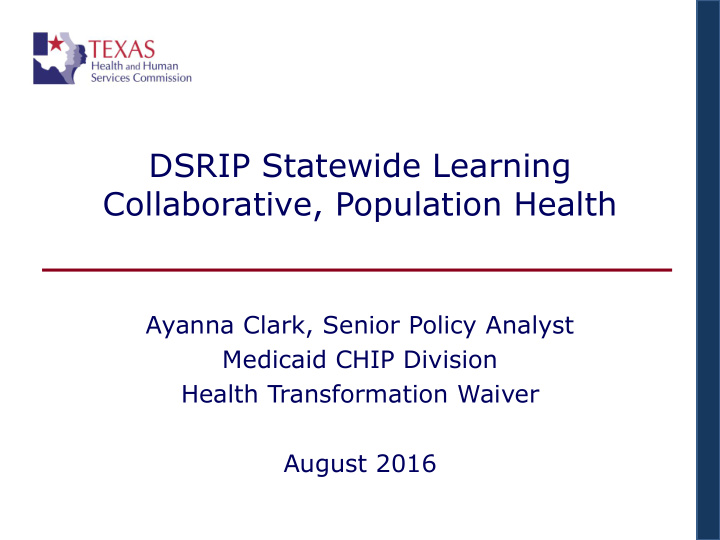



DSRIP Statewide Learning Collaborative, Population Health Ayanna Clark, Senior Policy Analyst Medicaid CHIP Division Health Transformation Waiver August 2016
Topics of Discussion 1.An overview of population health and its importance 2.A discussion of DSRIP Statewide Analysis 3.A highlight of other health outcome data available to stakeholders: o DSRIP Category 4 Data o Texas Department of State Health Services, Center for Health Statistics- Texas Health Data System 2
What is Population Health? • There are various definitions of population health, but it was first defined in 2003 as the health outcomes of a group of individuals , including the distribution of such outcomes within the group . • The different concepts of population health fall along a spectrum ranging from the focus on health outcomes in populations defined by geography or similar factors , to accountability for health outcomes in populations defined by healthcare delivery systems . 3
What is Population Health? Continued… • The term population health describes both: • A clinical perspective focused on delivery of care to groups in a health system; and • A broad perspective focused on the health of all people in a geographic area and emphasizes multisector approaches and incorporation of nonclinical interventions to address social determinants of health. 4
What is Population Health? Continued… Accountability for health outcomes in populations leads providers • to address upstream factors such as health promotion and care coordination that influence health outcomes in "their" population. Population health requires the consideration of a broader array • of the determinants of health and recognize that responsibility for population health outcomes is shared. To improve population health, communities must establish and • nurture partnerships that include, but go beyond state and local public health agencies, local public health agencies and healthcare delivery systems. This broad system of partners must share data and adopt systems • that identify accountability for the measure’s contributions to population health outcomes. 5
Socio-ecological Model The Future of the Public's Health in the 21st Century, Institute of Medicine, 2003 6
Population Health Model 7
The Importance of a Common Set of Population Health Outcomes A common set of population health outcomes provides a • portrait of a community's health. Data can help residents, community groups, and professional organizations prioritize prevention activities and build coalitions to make improvements and address existing problems . A common set of population health outcomes can • facilitate comparisons across populations, promote collaboration between organizations conducting assessments, assist in establishing a shared understanding of the factors that influence health, and help to galvanize residents to work collaboratively to improve community health . 8
CMS Quality Strategy • The mission of the CMS Quality Strategy focuses on: • Improving outcomes • Beneficiary/consumer experience of care • Population health • Reducing healthcare costs through improvement 9
DSRIP Statewide Analysis • HHSC continues to work with ICHP to provide an ongoing analysis of select health outcomes at the regional and state level • Selected measures includes available data that aligns with DSRIP projects or state priorities • Data provided reflects Medicaid Managed Care data as well as some all-payor data • Data may not always be reflective of the entire DSRIP population 10
DSRIP Statewide Analysis Plan The measures highlighted in DSRIP Statewide Analysis • include: 3M Potentially Preventable Event Measures (PPA, PPC, • PPR, PPV) AHRQ Adult and Pediatric Quality Indicators (PQI and • PDI) such as diabetes and hypertension admission rates Utilization of Care Measures including outpatient and ED • visits HEDIS Measures related to behavioral health • HEDIS Measures related to access to care measures such • as breast cancer screening & frequency of ongoing prenatal care 11
Other Statewide/RHP Data Available DSRIP Category 4 The HHSC Transformation website also includes • Calendar Year 2013 data (DSRIP and UC providers only) stratified by RHP for: Potentially Preventable Admissions; • Potentially Preventable Readmissions; and • Potentially Preventable Complications. • http://www.hhsc.state.tx.us/1115-RHP-Plans.shtml •
Accessing State and County Healthcare Outcome Data The Texas Department of State Health Services, • Center for Health Statistics , provides a Texas Health Data system , which is an interactive public data system that allows you to query DSHS public health datasets for statistical reports and summaries. http://healthdata.dshs.texas.gov/Home
Texas Health Data DSHS Center for Health Statistics Contains links to public data and statistics on various public • health topics such as: Texas Health Facts Profiles (county and regional profiles that • include data such as socioeconomic indicators such as number of TANF recipients, births, deaths, demographics) Disease and Trauma Surveillance data such as Texas injury • statistics (ex: number of assault injuries by state, trauma service area, public health (PH) region or county) Healthcare Utilization & Quality data , such as number of • inpatient hospitalizations by payor source filtered by state, county, metro area or PH region Health Risks and Preventions such as percentage of adults • categorized as overweight or obese based on self-reported body mass index (BMI) (Texas Behavioral Risk Factor Surveillance System) Database includes links to data sources and methodologies •
Conclusion Population Health looks at health outcomes of a group of • individuals, including the distribution of such outcomes within the group. The “population” assessed can be defined by geography, health • systems or other similar factors. Population Health has been used to describe both a clinical • perspective of health and a broader perspective of health that focuses on the social determinants of health. A common set of population health outcomes can: • facilitate comparisons across populations, • promote collaboration between organizations • assist in considering factors that influence health , and • Promotes individuals/groups to work collaboratively to improve • community health . 15
Recommend
More recommend